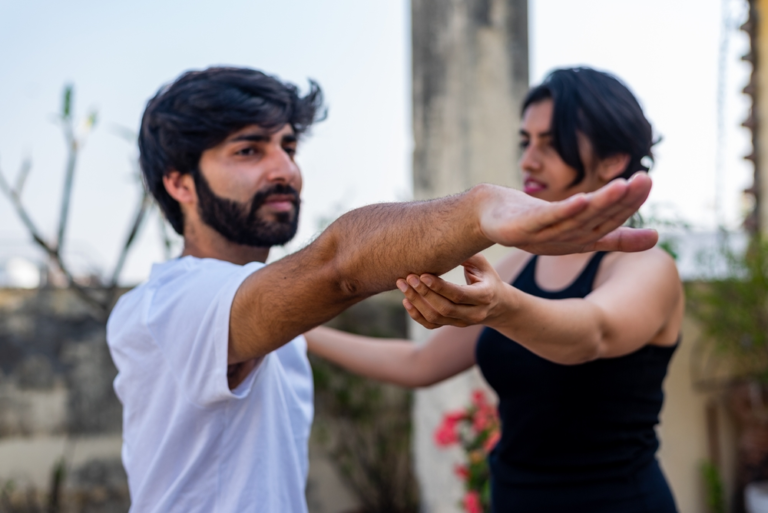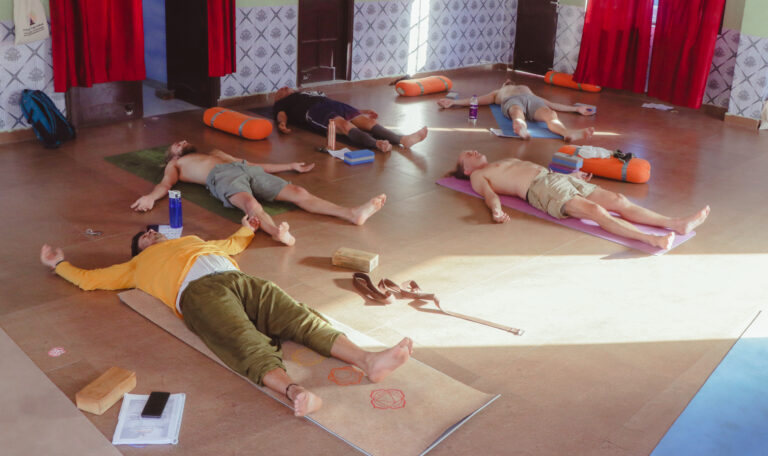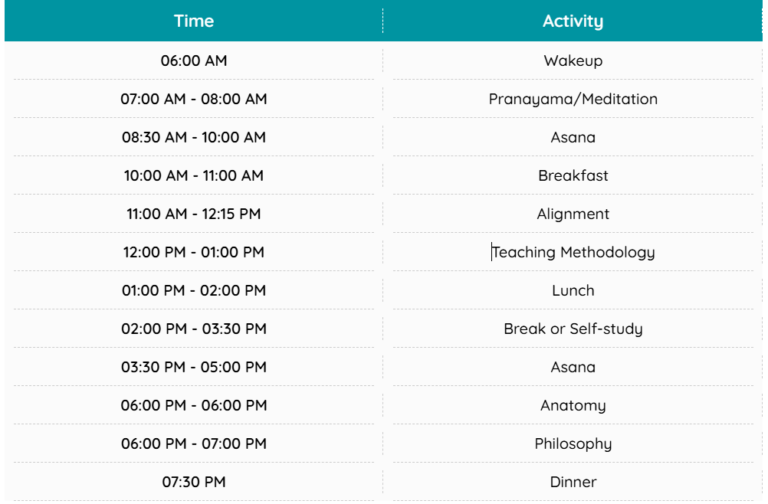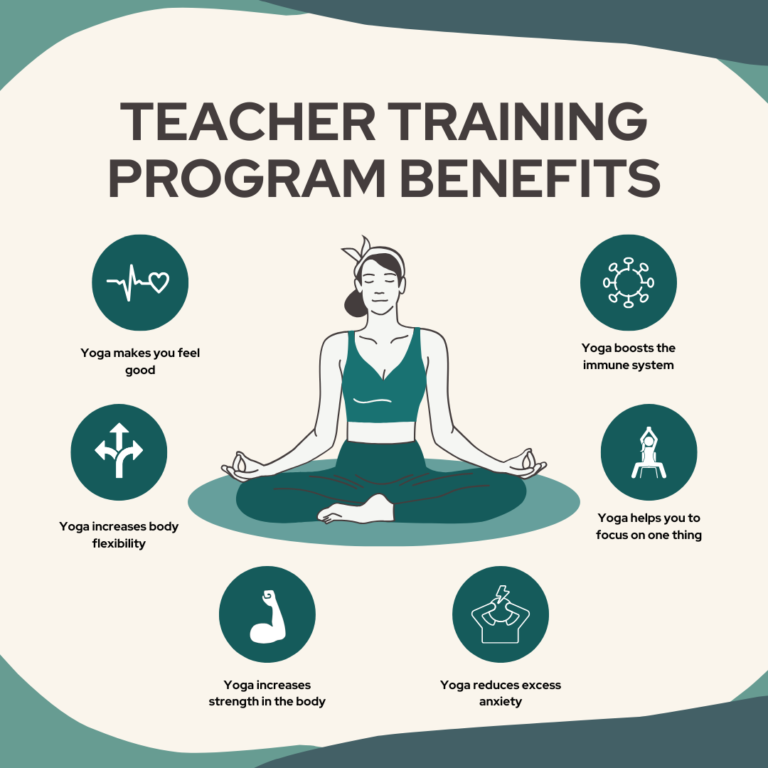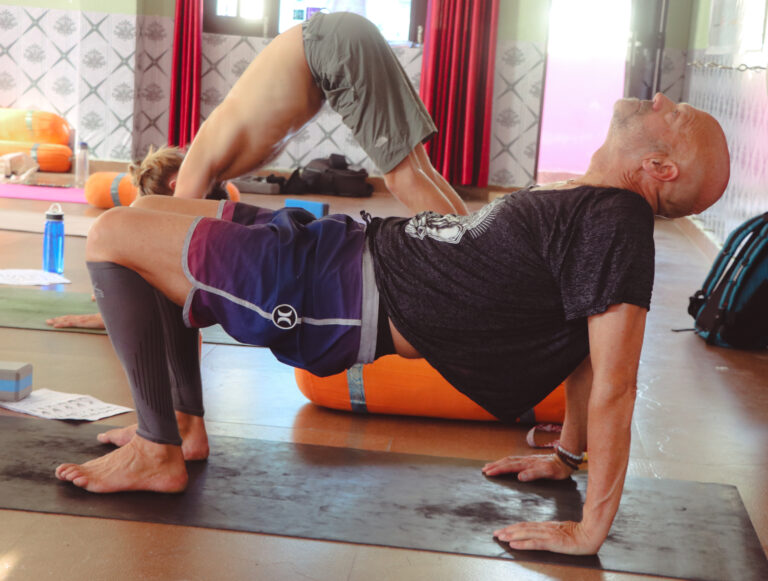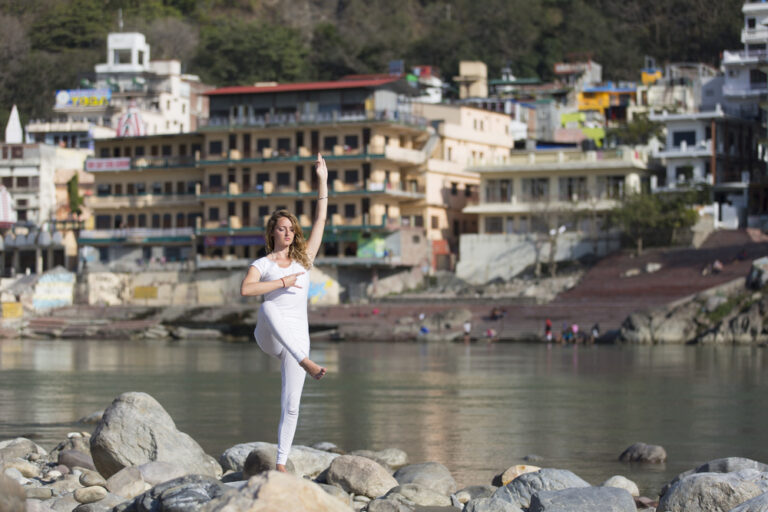Have you contemplated why an ancient practice like yoga still captures the mind of modernity? Where trends are changing, but finding the way of health and well-being still goes through the practice of yoga.
Probably because of its promise of physical fitness, serenity, and spiritual enlightenment, or the simple charm of being just peacefulness in a whirlwind called life.
Whatever brought you to it, it is likely that you have heard of Patanjali’s model of the eight limbs of yoga (ashtanga means eight limbs) practices that are believed to prepare human beings for a more fulfilling life. The eight limbs are a general road map for personal growth and transformation in the Yoga Sutras narrated by a sage named Patanjali.
He defined the eight limbs as
- Yamas (Abstinences)
- Niyama (Observances)
- Asana (Posture)
- Pranayama (Breathing)
- Pratyahara (Withdrawal)
- Dharana (Concentration)
- Dhyana (Meditation)
- Samadhi (Absorption)

In this blog post, we will cover the various angles of these eight limbs in modern-day life. We will explore the grounded, applied aspect of the teachings, offering guidance as well as practical tips for incorporating these teachings into our lives.
Whether you’re an experienced yogi or just a curious beginner, these perspectives will inspire you to deepen the practice of yoga.
Let’s take the plunge!
People also read:
How Pranayama Can Transform Your Yoga Practice
Beyond Asanas: What You’ll Learn in a 300-Hour Yoga TTC
The Eight Limbs: A Deeper Understanding
1. Yama (Abstinences): The Ethical Foundation of Yoga
The first limb of yoga, Yama, emphasizes the ethical codes of human conduct towards ourselves and the world. Five such ethical restraints, termed yamas, embody a moral compass for living a virtuous life. Here we examine them individually:

Ahimsa: The Path of Non-Violence
Ahimsa, mostly understood as non-violence, means more than just physical peace; rather, it covers our thoughts, speech, and action. Practicing ahimsa allows for the development of compassion, empathy, and kindness toward all beings.
Here are some ways one can bring ahimsa into daily life:
- Speak Mindfully: Choose your speech rightly by refraining from using a vocabulary that hurts.
- Give Compassionate Service: Be kind and considerate toward others.
- Avoid a Judgmental Attitude: Acceptance and understanding should prevail.
- Give Veganism or Vegetarianism a Thought: Think about adopting a vegetarian or vegan diet.
Satya: The Path of Truthfulness
Satya, or honesty and truth, is crucial for building trust and integrity. It is honest to all; hence, it has to be with oneself. When we put honesty into our speech, our present character gains strength against all challenges in life.
Fostering truthful speech and self-awareness:
- Self-Introspection: Practicing self-awareness; accepting how you genuinely feel.
- The Freedom to Speak Openly: Confess Honest Thoughts and Feelings.
- Both honest and ethical: Avoid gossip and slander; avoid all hurting speech.
- Soulful listening: Attending to and understanding another person’s perspective.
Asteya: The Art of Non-Stealing
Asteya, or the act of not stealing, extends beyond just owning physical possessions. It also includes stealing time, energy, and attention. Engaging in asteya allows us to foster respect for the belongings and resources of others.
Mindful Consumption and Strategies for Ethical Living:
- Mindful Spending: Ask yourself the implications of the purchases and keep from unnecessary purchases.
- Time Management: Use the time wisely, neither squandering time nor doing something that could be agreed upon as a distraction.
- Respectful Relationships: Put high regard on the time and energy of those around you.
- Ethical Consumption: Patronize businesses that champion sustainability and just labor practices.
Brahmacharya: The Practice of Moderate Living
While Brahmacharya is often related to celibacy, it should more appropriately be defined as moderation. Balancing all desires and practicing self-control can alternate their impact in this life.
Here are a few sample applications of brahmacharya:
- Secure Relationships: Setting healthy boundaries and respect in communication.
- Balanced Lifestyle: Not overindulging in food, drinks, and other pleasures.
- Mindful Consumption: Being aware of their habits and not over-consuming.
- Focused Energy: To direct the energies toward something productive and valuable.
Aparigraha: The Joy of Non-Possession.
Aparigraha is also called non-possessiveness. It encourages us to let go of all material attachments and learn to embrace a minimalist mindset. When we free ourselves from the burdens of material needs, we find greater freedom and joy.
Some of these include decluttering both the physical and mental spaces:
- Minimalist Living: Simplify and declutter the whole house to retain only the things you need.
- Digital Minimalism: Stay away from screens or rest from screens; be intentional as to what digital experiences you want.
- Mindful Consumption: Actively consider what you purchase and resist cluttering around yourself with unnecessary products.
- Letting Go of the Past: Allow your regrets from the past and bad vibes to pass you by.
2. Niyama (Observances): The Ethical Observances
Yama deals with external actions, while Niyama looks into our internal practices. These five observances help us cultivate a positive mindset and a deeper connection to ourselves and the Divine.
Purity of Body and Mind:
Saucha is considered to be vital both for health and hygiene. This involves physical, mental, and spiritual cleanliness. By keeping our homes clean and tidy, providing wholesome food for our bodies, and remaining mindful, we can develop an inner feeling of peace.
Healthy lifestyle practices for a positive attitude:
- Physical Happiness: The bath and the cleansing of body and mind.
- Healthy Nutrition: Healthy foods nourish the body.
- Regular Exercise: Get moving for a great boost of energy.
- Mindful Living: Mindfully live—the sooner you practice, the better.
- Affirmative Thinking: Think positive: count your blessings.
Santosha: Contentment
Santosha is just the joy of the present moment. Gratitude turns the key to this receptacle; with enough of it, we shatter the illusory walls of hope, yearning, and want and set free into the space of everlasting contentment and peacefulness.
Ways to combat dissatisfaction and eventually embrace contentment:
- Practicing Gratitude: Express once a day something you are grateful for.
- Mindful Living: Be present, and do not think about the past or the future.
- Accepting Imperfections: Be okay with your failings and difficulties.
- Letting Go of Control: Give up your tight reins on everything.
- Practicing Patience: Train yourself with patience and unwavering perseverance.
Tapas: The Fire of Self-Discipline
Tapas involves everything relating to personal development and growth. It consists of continuous, precise efforts and white-knuckled determination, spiced with more than a hint of willingness to step outside the comfort zone.
Tips for setting and attaining goals and remaining motivated:
- Set Clear Goals: Define specific, measurable, achievable, relevant, and time-bound goals.
- Break Goals Down: Segment big objectives into slices that can be easily handled.
- Build a Daily Routine: Follow an unbroken structure on a daily basis.
- Seek Societal Support: Interact with people in a similar mind frame for nudges and encouragement.
- Celebrate Each Milestone: Own achievements and take a reward for it.
Svadhyaya: The Journey of Self-Discovery
The journey of self-discovery, called Svadhyaya, is a climb down the rabbit hole of one’s own mind and soul. It guides us to discover our nature through blessed reading, meditation, or self-reflection.
Applications to Really See Yourself:
- Meditation: One must really calm their mind and reach deeper still to find their pure self.
- Create a Journal: going through things, thoughts, and experiences.
- Yoga Nidra is the state of including high relaxation with present or sudden attention.
- Read: Pick some grains of wisdom from the ancient teachings.
- Questioning Yourself: Raise burning questions to dig deeper into the matter.
Ishvara Pranidhana: Surrender to the Divine
Ishvara-Pranidhana means surrender unto God, a relinquishment of control and faith in the hands of a higher power. It is through surrender to something far beyond ourselves that we can taste the deep waters of peace and release.
Ways to build surrender and faith:
- Prayer and meditation: Connect with God through prayer and meditation.
- Trusting the Universe: Let go of the desire to control the outcome.
- Accepting Imperfection: Acceptance of your limitations and imperfections.
- Service Others: Selfless service allows one to grow and reach a dimension beyond their normal ego plane.
- Finding Your Spiritual Path: Explore different modalities of a spiritual path until one simply resonates with you.
3. Asana (Asana): The Physical Practice of Yoga
Asana basically means the puritanical postures of yoga, and it’s the prompt for most people when they think of yoga. Numero uno, though; it’s important to note that asana is but one limb out of eight.
- Discerning connection: this is the right posture in alignment with breathing and mindful supplication.
- The Proper Alignment: Getting into the right alignment will save you from injuries, going deeper into the posture, and doing it correctly.
- Emptying your mind: Breath, or pranayama, is also a very important part of asana practice. By synchronizing breath with movement, you can reach higher levels of accomplishment and energize your body.
- Consciousness: The real change that can happen in your yoga may only come with being aware. Awareness gives you an opportunity to really listen to your body and mind.
Asana Common Misconceptions:
- Flexibility Comes First: Flexibility is good; with yoga practice, you might become flexible. However, the actual point of asana remains stability and strength.
- The More Extreme, the Better: You should listen to your body and not push that much. A gentle and mindful practice is usually more beneficial than a vigorous one.
- Asana Only Relative to Physical Health: Asana helps you on a holistic level so that you become a better physical, mental, and spiritual being.
Always remember: the actual purpose of asana is to prepare the body to meditate. To meditate more efficiently, you can keep your body strong, supple, and balanced.
4. Pranayama (Breathing): The Science of Breath
Pranayama, or breath control, is a potent tool for enhancing physical and mental well-being. By controlling breath more or less consciously, we can control energy levels, mood, and well-being—that is, everything affecting one’s well-being.
Science Behind Breath:
- Oxygenation: With deep, slow breathing comes a greater oxygen intake, nourishing the cells and enhancing brain performance.
- Stress Reduction: Paradoxically, pranayama techniques activate the parasympathetic nervous system, promoting relaxation and reducing stress.
- Enhances Focus: Calming the mind, pranayama enhances concentration and focus.
- Boosts Immunity: Deep breathing can result in improved immunity.
Common Pranayama Techniques and Applicable Benefits:
- Anuloma Viloma (Alternate Nostril Breathing): This makes one balanced between the left and right hemispheres of the brain, creating calmness and focus.
- Bhramari Pranayama (Bee Breath): Known as gentle breathing, it is a very good soothing technique useful for the mind to calm down in anxiety.
- Kapalbhati Pranayama (Skull Shining Breath): It is a very powerful breathing exercise, stimulating the digestive fire and energizing the body; very useful for countering tiredness.
- Nadi Shodhana Pranayama (Alternate Nostril Breathing): Balancing the nadis (energy channels) in the body leads to the balance of the whole being.
Integrating Pranayama Into Daily Life:
- Morning Practice: Start your day with a few moments of deep, conscious breathing. Breathe into a more correct feeling for the rest of the day.
- Mindfulness During the Day: Again, many of the same little breathing exercises can be included throughout the day: at work breaks;
- Yoga Nidra: The highest form of rest and guided meditation; includes pranayama techniques to further encourage the healing and rejuvenation process.
- Meditation: Most meditative practices employ prescribed breathing techniques to calm the mind and enhance focus.
Thus, regular practice of pranayama can provide one with varied benefits too, such as decreased work stress, improved sleeping, enhanced energy level awareness, and greater compassion. The important thing is just to find the practice that construes how you can live your lifestyle and, at the same time, fit it in as per your own preference.
5. Pratyahara (Withdrawal): Turning Inward
Pratyahara, the fifth limb of yoga, is the art of withdrawing the senses from external stimuli. By directing our attention inwards, we can feel a greater sense of peace and focus.
Ways to lessen distractions and cultivate peace:
- Mindful meditation is traditionally practiced so that one focuses all their energies at that moment, removing distractions that arise from past and future thoughts.
- Yoga nidra: This technique of deep relaxation will take you to profound relaxation when guided to withdraw your senses.
- Sensory retreat: Spend a bit more time in quiet, nature-filled environments away from the overstimulation.
- Digital detoxing: It is vital to take screen breaks to refresh the mind, kick mental fatigue in the shin, and improve focus and concentration.
Through the experience of pratyahara, we can quiet the mind, lessen our worries, and feel a deeper connection with who we are.
6. Dharana (Concentration): The Art of Focus
The sixth limb of yoga is Dharana, where the mind is focused on one single point. With the help of focused attention, we train our mind to be more focused and disciplined.
Techniques to Add Concentration and Reduce Mental Clutter:
- Meditation: Meditation, in regular practice, enhances concentration and reduces mental noise.
- Single-Pointed Focus: Focus on something specific like a candle flame and/or a mantra.
- Breath Awareness: Focus on your breath and be aware of the feelings in between inhalation and exhalation.
- Mindful Walking: Focus on bodily sensations while walking, such as the sensation of your feet touching the earth and the rhythm of your breath.
Dharana can be regarded as a precursor to meditation. As you increase your ability to concentrate, you go deeper and deeper into meditation, thus gaining peace of mind and clarity.
7. Dhyana (Meditation): The Path to Inner Peace
Meditation is Dhyana, the seventh limb of yoga, and the summit of the previous six. All the six limbs lead to a final, stilling of mind and ultimately a thought-steady state, producing calm and peace of mind.
Types of Meditation and Their Benefits:
- Mindfulness Meditation: Case examples that likely focus on the details of living right now, wherein thoughts and sensations are observed without stimuli of the mind to judge them.
- Transcendental Meditation: The procedure involves silently repeating a mantra.
- Loving-Kindness Meditation: This involves breathing out alongside visualization of compassion and love toward oneself, then into the world.
- Breath Meditation: Focuses on the breath, observing the sensation of each inhale and exhale.
How to introduce meditation into an otherwise hectic life:
- Start Small: A two- or three-minute meditation is good for the beginner.
- Find a Quiet Space: Attain such a space with no distractions when you’re ready to meditate.
- Use an app: Such apps provide guided meditations, timers, and sounds to help maintain focus.
- Mindful Breathing: Periodically, practice calm, observant inhalation and exhalation exercises to reduce stress and enhance awareness.
Regular meditation can help to resolve your body from stress and provide you with a more improved focus and a more relaxed state of mind in the simplest possible way.
8. Samadhi (Absorption): The Ultimate Goal
Samadhi is the eternal eighth and final limb of yoga, the goal of yogic practices. It is a state of profound peace and wisdom, a condition of realization, where the individual consciousness merges with universal consciousness.
Stages of Samadhi and Their Relevance:
Although the nature of samadhi may be intricate, it has been repeatedly discussed. Patanjali speaks of specific stages:
- Savikalpa Samadhi: Meditative deep awareness with a specific object of focus.
- Nirvikalpa Samadhi: Purest consciousness, without any specific object of focus.
Nearer to Enlightenment:
Passing through a long, arduous road, achieving full enlightenment may be far from reach, but with regular practice of the eight limbs of yoga, one may come nearer to this end. As we focus on ethical being, on mental and physical discipline, and on spiritual awareness, we naturally become purer from within, thus attaining deeper levels of peace and bliss.
Remember that enlightenment is not simply a destination; rather, it constitutes a lifelong process. Be patient, persistent, and kind to yourself.
Conclusion: Your Journey Begins
Those comments should be like your first step—the journey begins.
Having had the opportunity to look into the eight limbs of yoga, you have discovered a full scale at a personal level for growth, a path for spiritual awakening, and well-being. Remember, yoga is not just a burning exercise; it is a holistic pursuit that applies to all aspects of your life.
Incorporating into your life the principles of Yama, Niyama, Asana, Pranayama, Pratyahara, Dharana, Dhyana, and Samadhi will initiate great transformation.
So how do I get started?
- Taking baby steps is always good: Practice some minutes of meditation or a short yoga session daily as a start.
- Develop multi-tasking with compassion: Change takes time. Never lose heart if there are no visible results in the beginning.
- Ask for help: Go to a yoga class or engage a competent yoga teacher.
Above all, the path of the yogi is highly personal. There is no one “right” or “wrong” way to practice; only the way that works for you. Most important is to have fun on your way there.
Happy practicing, and welcome peace and joy into your life and enlightenment.
You might also like: Ashtanga vs. Vinyasa: Which Flow is Right for You?
You might be interested in our Short Yoga Retreats from Kaivalyam
| 3 Days Yoga Retreats in Rishikesh, India |
| 5 Days Yoga Retreats in Rishikesh, India |
| 7 Days Yoga Retreats in Rishikesh, India |
| 10 Days Yoga Retreats in Rishikesh, India |
Yoga Teacher Training Courses from Kaivalyam

